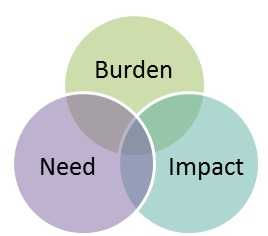Burden, Need, and Impact

How NIOSH Identifies research priorities: Burden, Need, and Impact
NIOSH uses what we refer to as the BNI Method to identify and define research priorities. BNI is the acronym for Burden, Need and Impact. The central tenets of the BNI Method are that NIOSH:
- Must do the most important work to protect the workforce,
- Must identify research priorities to guide the investment of limited resources in a clear and transparent manner, and
- Base these priorities on the evidence of Burden, Need and Impact.
What do we mean by Burden, Need and Impact?
Burden provides evidence of the health and safety and economic burden (or potential burden) of workplace risks and hazards. In considering these burden estimates, we will also consider how well the burden evidence is assessed. Emerging issues, understudied populations or hazards, which would not have established burden due to their emerging nature, would have potential burden that can be described by many of the same parameters of established burden – such as potential for injury, illness, disability and mortality.
Need helps define the knowledge gap the proposed research will fill. It considers the comparative advantage NIOSH has over other funding agencies and the unique resources NIOSH might have to respond to research need. Need is where stakeholder needs are identified and addressed.
Impact is where we consider how well the research is conceived and likely to address the need. Impact or potential for impact helps us consider if the proposed research can create new knowledge, lead others to act on findings, promote practical intervention, adopt a new technology, develop evidence-based guidance, aid in standard setting or promote other intermediate outcomes. Consideration of impact is where we look to see if the proposed research will likely lead to a decrease in worker injury, illness, disability or death, or enhance worker well-being.
- Page last reviewed: May 31, 2017
- Page last updated: December 8, 2016
- Content source:
- National Institute for Occupational Safety and Health Office of the Director


 ShareCompartir
ShareCompartir